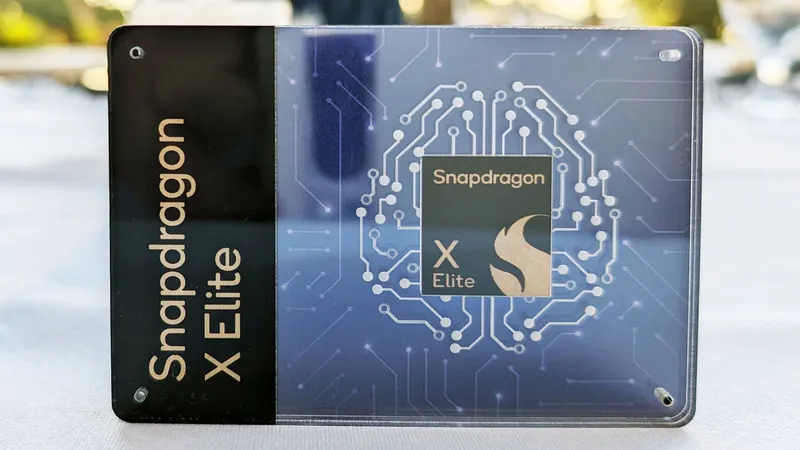
Can Qualcomm Make Waves in the Desktop CPU Market by 2025? Here’s What You Need to Know!
2024-12-25
Author: Sarah
Qualcomm has been making headlines lately with its Snapdragon X Elite chip, which promises impressive performance and exceptional battery life, particularly for laptops. The excitement surrounding this chip escalated when it officially launched in June, showcasing a remarkable Windows-on-Arm experience that rivals even Apple's renowned MacBook lineup.
One standout example of the Snapdragon X Elite's capabilities is the Microsoft Surface Laptop 7, which received glowing reviews for its stellar performance and an impressive battery life of nearly 16 hours. Both achievements are largely attributed to this advanced chip, indicating that Qualcomm's technology is making significant strides in the PC market.
But what does this mean for Qualcomm's potential entry into the desktop CPU arena? With compatibility issues still lingering in the Windows-on-Arm ecosystem, many are left wondering if Qualcomm can truly rival Intel and AMD, two titans of the desktop CPU space, by 2025.
Snapdragon X Elite: A Game Changer?
Qualcomm's current portfolio of Arm-based chips, including the Snapdragon X Elite and X Plus, have demonstrated a formidable performance advantage over their x86 counterparts. Recent tests by Tom's Hardware revealed that the Snapdragon X Elite outperformed Intel and AMD chips by a striking margin of 18 to 25% in Geekbench 6 scores. However, it’s essential to note that these figures primarily reflect performance in laptops, where energy efficiency and battery life are critical.
Though Qualcomm initially planned to release a Snapdragon-powered mini PC to capitalize on this momentum, the project was scrapped in October due to quality concerns. Many tech enthusiasts had high hopes for this device to disrupt the Mini PC segment, highlighting Qualcomm's broader ambitions for desktop computing.
As Qualcomm CEO Cristiano Amon stated, the company's strategy includes launching a variety of desktop solutions in the future. "You're going to see us with a lot of designs on desktops, mini desktops, and eventually, you won't be surprised of us still thinking about high-performance desktop," he noted.
The Competition: A Tough Landscape
Despite Qualcomm's advancements, AMD and Intel have a long-standing dominance in the CPU market. When building a PC, most consumers prioritize these established brands for the best price-to-performance ratio. Currently, AMD is favored for gaming builds, while Intel is the go-to for productivity-focused PCs. To carve out a niche, Qualcomm would need to position its chips as the "most affordable" option.
If Qualcomm manages to replicate the competitive pricing of their mini PC—priced at $899—through standalone desktops or CPUs for DIY builds, it could attract budget-conscious buyers. But even with attractive pricing, there are significant hurdles to overcome. The compatibility issues with Windows-on-Arm could hinder performance, particularly for gaming. While a Snapdragon X Elite laptop was able to run Baldur's Gate 3 at 4K with commendable frame rates, its true capabilities in a desktop environment remain untested.
Potential Disruption from Nvidia
Adding to Qualcomm's challenges is the emergence of Nvidia, which reportedly plans to release its own Arm-based chip for Windows in 2025. Known for its leading graphics cards, Nvidia has already earned the trust of PC builders and could pose a significant threat to Qualcomm's aspirations. If Nvidia successfully combines its CPU and GPU capabilities into a unified solution, it might outshine Qualcomm in the desktop market.
The stakes are high. Both Qualcomm and Nvidia will need to focus on software compatibility to ensure their chips can leverage the advantages of the Windows operating system effectively. Without solid software support, even the most powerful chips won’t be enough to shake the strongholds that AMD and Intel have on the market.
Conclusion: The Road Ahead
Overall, while Qualcomm has the groundwork and ambition to enter the desktop CPU market, its success by 2025 remains uncertain. The potential for innovative Arm-based solutions exists, but whether these advancements will challenge the established giants of AMD and Intel is still an open question. As competition heats up with potential entries from Nvidia, Qualcomm will need to execute flawlessly and consider market demands to make a meaningful impact. Only time will tell if Qualcomm can turn its potential into reality or if it will remain a budding player in the shadows of industry leaders.




 Brasil (PT)
Brasil (PT)
 Canada (EN)
Canada (EN)
 Chile (ES)
Chile (ES)
 España (ES)
España (ES)
 France (FR)
France (FR)
 Hong Kong (EN)
Hong Kong (EN)
 Italia (IT)
Italia (IT)
 日本 (JA)
日本 (JA)
 Magyarország (HU)
Magyarország (HU)
 Norge (NO)
Norge (NO)
 Polska (PL)
Polska (PL)
 Schweiz (DE)
Schweiz (DE)
 Singapore (EN)
Singapore (EN)
 Sverige (SV)
Sverige (SV)
 Suomi (FI)
Suomi (FI)
 Türkiye (TR)
Türkiye (TR)